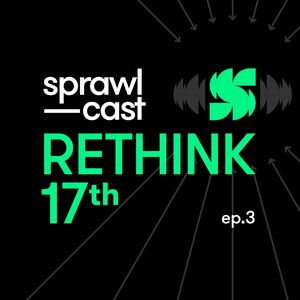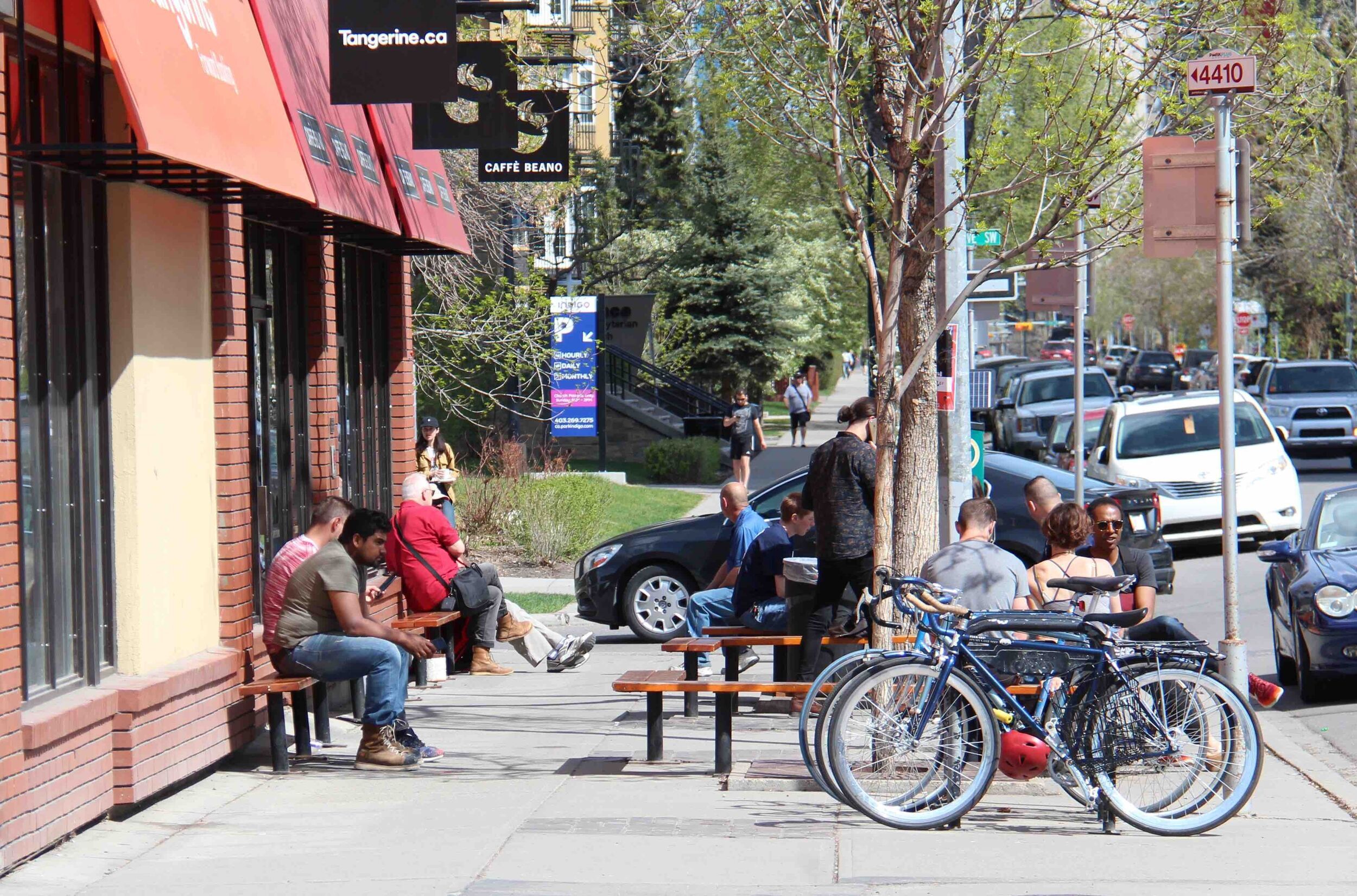
Sprawlcast Ep 3: Rethinking 17th Ave
Why isn’t the city’s $44M makeover bolder?
The fourth edition of the Sprawl is here! This Sprawl pop-up will be all about 17 Avenue SW and SE. Both of these streets are culturally, socially and economically significant to Calgary—and both are undergoing major construction this summer, shaped by different visions.
We begin with an in-depth Sprawlcast about the city’s $44M revamp of 17 Ave SW. In response to feedback from our audience, we’re doing something new: we have provided a full transcript of the episode below, along with photos and extra bits of research.
If you like what you read/hear, please support the Sprawl so we can keep doing in-depth local journalism like this!
JEREMY KLASZUS: You’re listening to Sprawlcast. It’s a collaboration between the Sprawl and CJSW 90.9 FM. My name is Jeremy Klaszus and I’m the editor and founder of the Sprawl. And we’re broadcasting from Calgary on Treaty 7 land. The way we do things has become a little clearer since the last episode of Sprawlcast. We’ve laid out a manifesto of 11 principles that guide everything we do.
We do depth, not breadth. Context, not clickbait. And we’re constructive, not cynical.
I’m really excited to bring you our third episode: Rethink 17th.

JEREMY: One of my favourite places to go on 17 Avenue SW is Caffe Beano. I like to get a coffee and sit on the benches outside—and just watch the city go by. And I know I’m not alone. Most of us are connected to this street, 17th Ave, in one way or another.
LEONORA ANDRÉ: I guess I like all the diversity of people and stores. You can find a little bit of everything.
JEREMY: This is Leonora André. She’s a photographer and she also works at Beano as a barista. She grew up in Chile and then spent a few years living in Buenos Aires. When she came to Calgary, she got a place a few blocks off 17th Avenue.
LEONORA: It’s like a mall, but it’s spread in just one big street. When you move to a new city, you just want to be near everything. So mostly we picked 17th Ave because of that.
JEREMY: A mall spread out over a street. 17 Ave has been performing this function in Calgary for over a century. I went to the Calgary library and into their local history room and pulled their file on 17 Ave. The earliest reference I could find was a 1910 article in The Albertan about a new retail district in the city’s southwest end: 17 Ave. And so there was a drug store, a grocery store, a clothing store and a shoe store.
Kind of sounds like the 17 Ave of today.

MARGIE GIBB: It’s always been a hub for Calgary.
JEREMY: This is Margie Gibb. She owns Caffe Beano and she also lives in the area.
MARGIE: We don’t have a lot of these kinds of streets that really reflect the personality and culture of the city.
JEREMY: This summer 17 Ave is changing. There’s a $44M road reconstruction project underway—but does this transformation go far enough, and what’s driving it? That’s what we’re going to explore in this episode of Sprawlcast.
Road redo ‘with some niceties thrown in’
JEFF BINKS: I think the main challenge with 17th is it’s kind of happened organically, without any real direction.
JEREMY: This is Jeff Binks. He’s with a group called the Red Mile Complete Street Advocacy Group. They want more to happen on 17th. So, for example, they want a cycle track to go down the street. And they want more off-street parking in the area so that if you’re coming in from the suburbs, you don’t have to worry about parallel parking.
JEFF: What you see down there so far is good. I mean, you have a great grouping of businesses. You’re starting to get some mixed use development down there and you have a very vibrant pedestrian kind of district. But it’s almost just sort of happened naturally over the years.
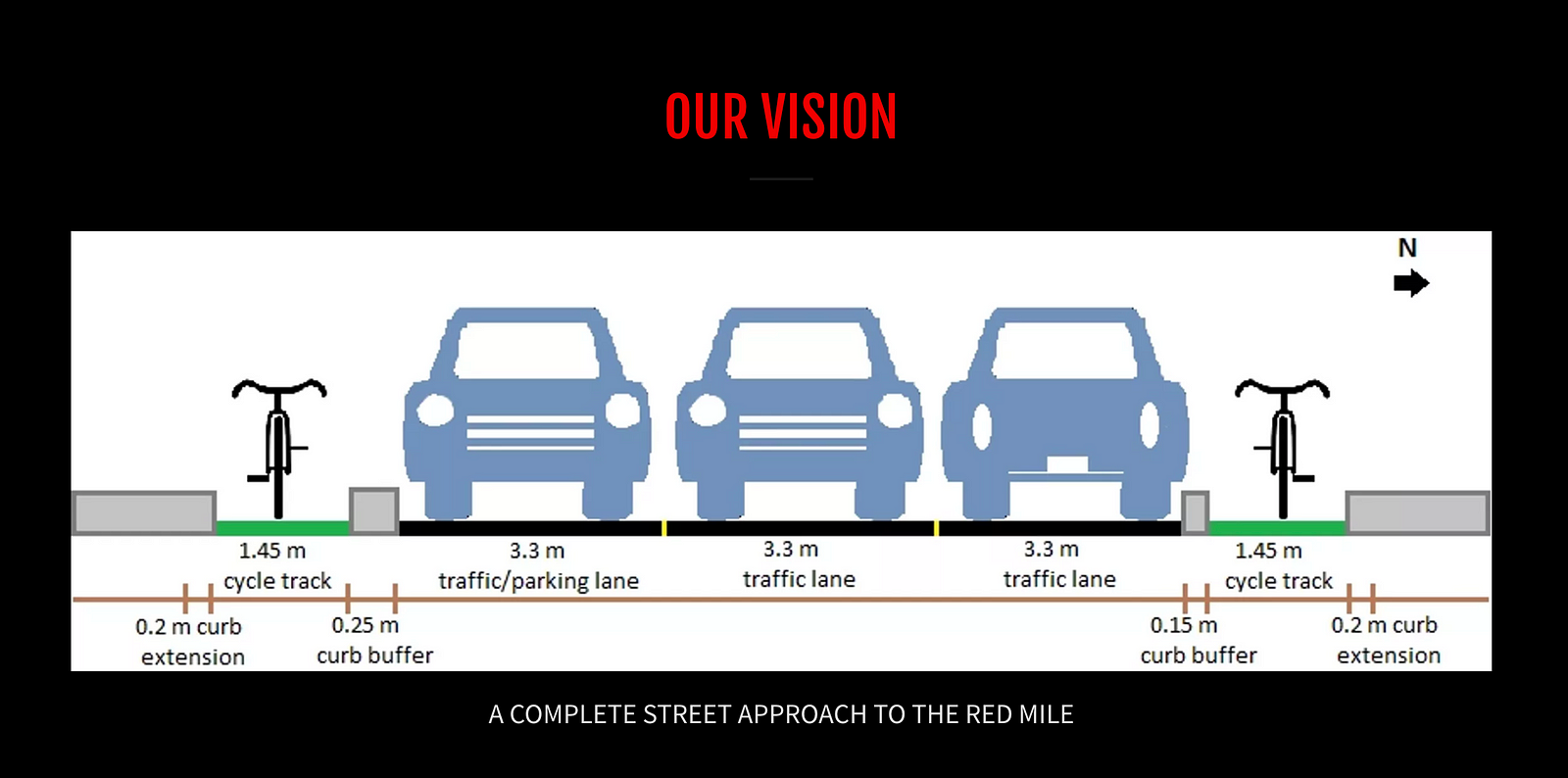
What you see from other cities is direction from city council, city administration—where they’ve decided this street is going to be our one great street. And they put an overwhelming vision forward that takes care of every aspect of the street from development to the streetscape to parking challenges. To make sure that they’re leveraging everything that they can to make the street the absolute best…
It’s coming across as a road project first, with some niceties thrown in, as oppose to: what do Calgarians want 17th Avenue to be and what can it actually become? And I think that’s the conversation that hasn’t really ever happened with 17 Ave that we’re hoping to launch now.
CITY OF CALGARY NARRATOR GUY: We’re investing in the future of 17 Avenue from Macleod Trail to 14 Street SW to make it a safer, more efficient and vibrant area for visitors, residents and drivers.
JEREMY: This is from a video on the City of Calgary’s website. The city is upgrading the underground utilities beneath 17 Ave and that means ripping out the road. And then, while they’re at it, they’re making some cosmetic improvements as well.
CITY NARRATOR GUY: We are fixing sidewalks and curbs, installing heritage-style street lights and planting new and replacement trees. Wider sidewalks, enhanced corners and improved crosswalk features at most intersections will offer a safer experience for those on foot.
JEREMY: What’s striking, when you look at the before and after renderings on the city website is how, well, it doesn’t look all that much different. They’re kind of minor changes.
But there are bigger changes on the way. You might have heard about Arlington, the Calgary developer who’s bought more than 40 buildings along 17 Avenue. They have plans of gradually turning 17th into a ‘high street’ akin to Robson Street in Vancouver. They want to make the whole strip more of a walkable destination.
So the city’s changes this summer are really the first of many.
‘Let’s spruce it up’
JEREMY: There’s a real range of opinion from business owners along 17th about all these changes. We’re going to hear a few of them. We’ll start with Margie at Caffe Beano. And then go a few doors down to a shop called Steeling Home. Jennifer Leblond is the owner there. And then we’ll go further west and hear from Sean Carter at BikeBike.
I asked Margie if she’s happy with the city’s plans.
MARGIE: I think they’re making an effort. Absolutely. I think they have a good plan. And they’re looking at it and kind of going, okay, we have to do this work. The utilities, the main has been under there for a long time. Let’s spruce it up while we’re at it.
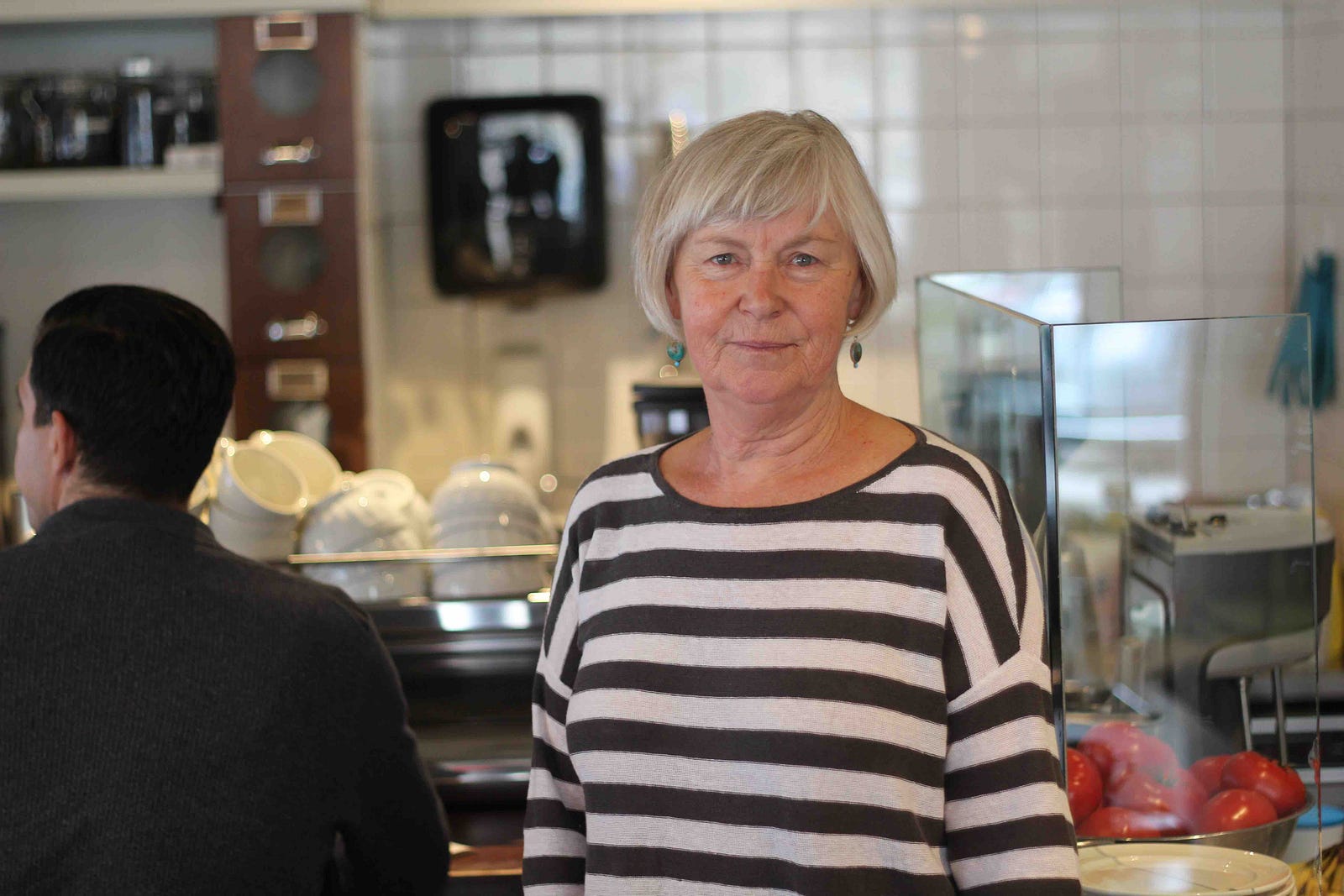
JENNIFER LEBLOND: I think it’s been challenging, it’s been good, it makes you think about things and not take things for granted. Because of this construction, it’s like renovating your kitchen. It opens up the living room and the downstairs — and should we put a second story on it?
So people are questioning how the street—not just the underneath, which is the main priority right now, it’s all the sewer mains and water mains—how it’s going to look afterwards on top.
‘A death-defying place to ride a bicycle’
SEAN CARTER: It’s a death-defying place to ride a bicycle. Anybody that rides a bike will tell you that 17 Ave is hostile. In spots it’s outright hostile. It’s too high-speedish, with cars going too fast, in certain areas. It’s too narrow in others. So that part kind of sucks, because I would like to ride down there.
JENNIFER: I like the eclecticness of it. I like the community of it. I like the fact that we have a school and we have a funeral home and we have one of the most coveted restaurants in Canada I think—Pigeonhole. We have the Ship & Anchor. It’s also a corridor so a lot of people use it to get to and from something. It does function as a lot of different things.
So I think when people try to pigeonhole it as ‘we’re going to try and make it a high-end neighbourhood,’ or ‘we’re going to make it a bicycle lane thoroughfare,’ or whatever their agenda is—I think they’ve lost the fact that it really belongs to a lot of people who also live in amongst it. It’s their corner grocery store. It’s their corner coffeeshop too.
Businesses are suffering
JEREMY: For other businesses, it’s all about survival. Never mind what the street will look like in a few years. They’re just trying to stick around for the next month. Take Fairmont Grill for example. They’re by 4th Street and they’re stuck behind the construction fence right now. It’s a Mediterranean fusion restaurant. Ahmed Dawud opened it a little over a year ago with high hopes.
AHMED DAWUD: We thought a business on 17th Avenue would attract a lot of tourists and a lot of Calgarians, both at the same time—and business would be booming.
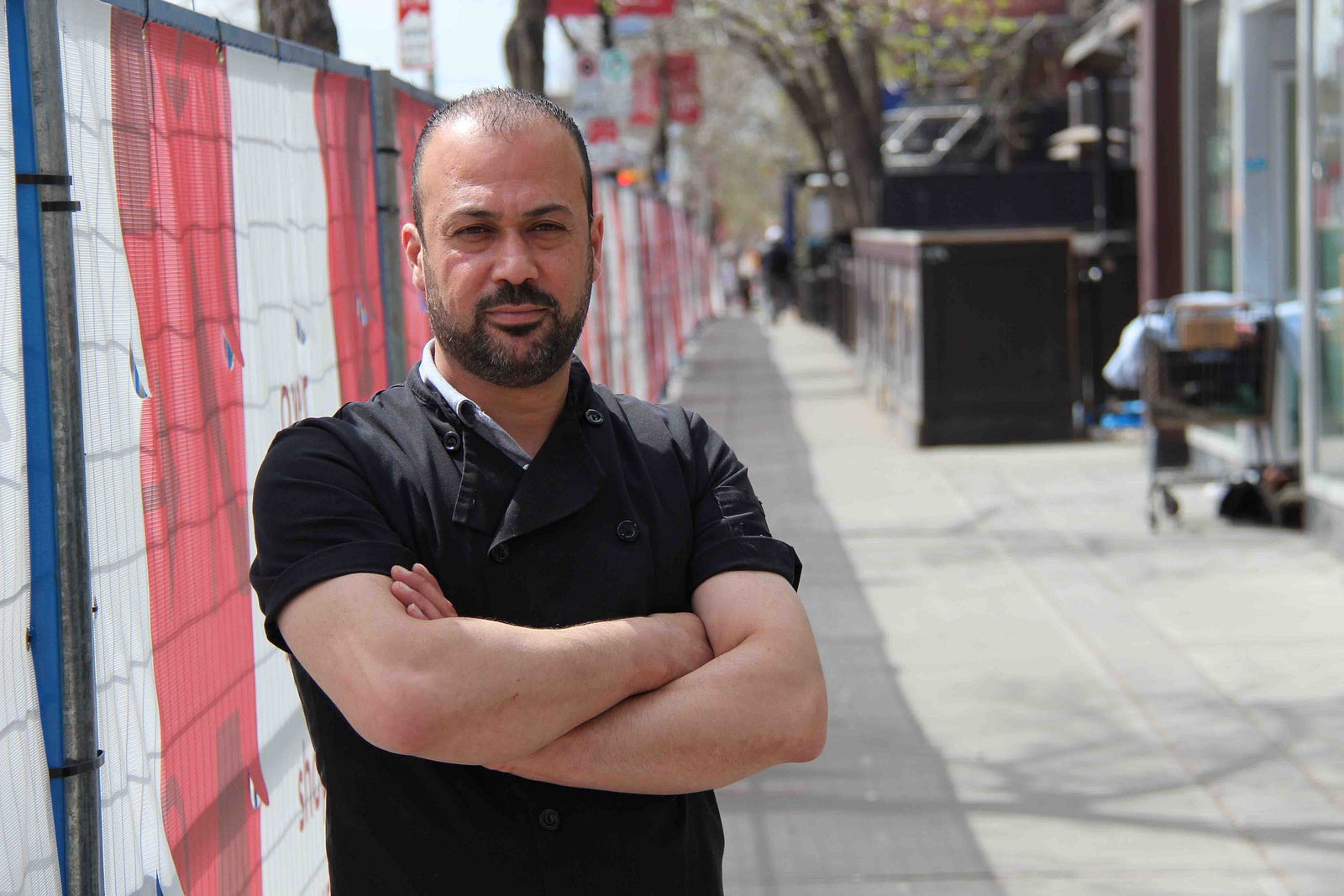
JEREMY: And how’s it been so far?
AHMED: Well, it’s been ridiculously slow. As they say, in Calgary it’s six months of winter and six months of construction. It doesn’t stop—and between this season and that season, businesses are suffering.
MARGIE: I do despair in regards to the loss of small business. I’m sad when I see box stores go in or that rents get so high that that’s all that can afford to be in this community. And that may well apply for other parts of Calgary as well. Because I think it’s that which makes it interesting. And the more we have to offer, the more people from all over Calgary will come here.
JEREMY: We often think of box stores as a threat to this kind of character. But could they be part of the solution? A little later in the show, we’ll talk to Rollin Stanley. He’s the city’s general manager of urban strategy.
And he says big stores like that have an important role to play.
ROLLIN STANLEY: You’ve got to think about it like you think about shopping malls. You’ve got Macy’s at one end and you’ve got Lord & Taylor at the other — the two big anchors. And then you have the activity between. We’ve got to move in that direction.
JEREMY: We’ll hear more from Rollin. But first, we’re going to swing into the Beltline.
‘A place of shopping, gathering, celebrating’
JEREMY: I’m here with Peter Oliver, president of the Beltline Neighbourhoods Association. Thanks for being here, Peter.
PETER OLIVER: Hey thanks for having me, Jeremy.
JEREMY: What is the vision for 17th Ave as you see it unfolding right now?
PETER: I think it’s first of all taking 17 Ave from a condition of disrepair. Blotchy, crooked, bumpy sidewalks. We had some nasty overhead power lines still. A lot of it was very very rundown. And so it’s bringing it up to a level I think that is now becoming closer to what the street is for Calgary in terms of significance. It’s a place of shopping, of gathering, of celebrating.
For the 23,000 roughly people who live in the Beltline and the surrounding communities like Mission, it’s sort of an extension of our living rooms. We live in condos and apartments, and so our lives kind of bleed out into the streets like 17 Avenue. It really forms the gel in the community in a lot of ways.
It’s sort of an extension of our living rooms. We live in condos and apartments, and so our lives kind of bleed out into the streets like 17 Avenue.
JEREMY: For sure. And who’s driving the vision for 17th, would you say? Who’s driving the bus? I know there are quite a few groups who have a stake in it.
PETER: It’s a good question. There’s the Business Improvement Area which runs 17th Ave. There’s the Beltline Neighbourhoods Association which represents the residents and tries to also support the businesses in the area. And then you also have the City of Calgary. But the vision right now I think is not really driven by anyone. Maybe that’s a problem.
What we’re seeing happening today, in terms of improving the public realm on 17th, really came out of the Ward 8 councillor’s office. Councillor Evan Woolley jumped on this opportunity when I think it was the roads department or the infrastructure department was announcing they were going to be digging up 17 Ave to replace all these aging pipes and infrastructure under the street.
And of course they were just going to go pour the sidewalks back and the roads back exactly how it was. He managed to jam his foot in the door and say wait a minute, let’s look at what we can do to improve this.
“The vision right now I think is not really driven by anyone. Maybe that’s a problem.”
There are activities happening on other main streets in Calgary like Marda Loop and Bowness Road that are a lot more visionary. And so it’s somewhat unfortunate that we had a bit of a missed opportunity on 17 Ave to really have that big exercise and think about what this street is. Because in a lot of ways these streets — like 17th Ave, like 33rd Ave in Marda Loop, like Bowness Road — they are much more important than just roads for moving cars and trucks and things.
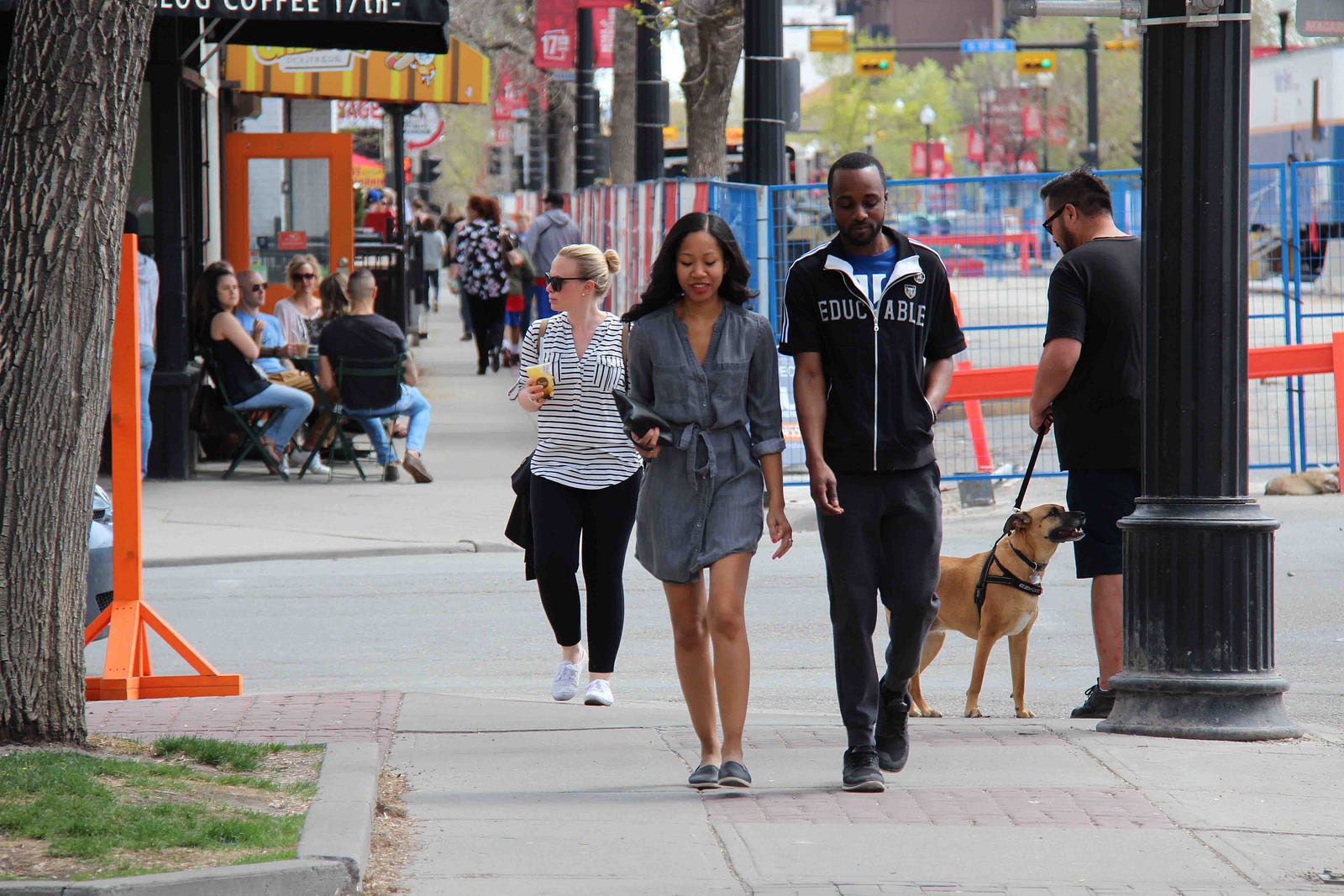
They’re meeting places, they’re places where we have shops and businesses, and so we have to think about them in a larger way. And think about how they bind the fabric of the different communities in Calgary, and form a home for culture and commerce and play this much greater role in Calgary.
‘Not all polished and shiny’
JEREMY: There’s more to this interview with Peter. But I want to bring in the area councillor, Evan Woolley. I asked him about the city’s project and about the overall vision — or, arguably, the lack thereof — for 17 Ave.
And if the city is making businesses suffer with this construction, shouldn’t there be a better payoff at the end?
COUNCILLOR EVAN WOOLLEY: When I travel to other cities, whether you’re in New York or Toronto or Montreal or Vancouver or Seattle or actually any of the great cities in the world that you go to — I just got back from Copenhagen a month ago, where I spent a week in one of the most beautiful cities I’ve ever been in. That it’s not all polished and shiny. That improvements are made.
And we talked a lot about this. That if we come in with $100M, we would end up with a very shiny, very expensive, polished product. And maybe that’s actually not what we would have wanted.
Even on a lot of the other main streets that we’re starting to make investments in, we’re not redoing everything. We’re making improvements.
“Could it have been more bold? Absolutely.”
There’s something about the grit and character of an old sidewalk that does have character to it. It’s a balance also of the money that we have available. And as we have been investing billions of dollars in infrastructure over the last four years in the city as a result of the economic downturn, we have to share that money in a whole bunch of different ways. And 17 Avenue is really important, I’m proud of that — it represents a $40M investment on one street. Could it have been more bold? Absolutely…
Had we done this differently, maybe we actually would have master planned the whole street to give some more thoughtful engaged work around that. But I’m excited about the work that’s underway.
It’s a huge impact on the street, obviously, especially now that we’re entering that core commercial area, but the product that comes out of the back end of this I think is something that everybody’s going to appreciate.
JEREMY: We’re going to go back to that interview with Peter Oliver of the Beltline Neighbourhoods Association. And I asked him basically the same question. I said, from where you sit, why is isn’t this transformation bolder?
‘More than just roadways for moving cars’
PETER: This comes at a time — and maybe the fact that people like yourself are noticing this — it’s coming at a time where the city is transitioning internally. And so they are coming to terms with the fact that streets are more than just roadways for moving cars and trucks. Even though we passed all the complete streets guides and everything years ago, if not a decade ago, that hasn’t really trickled down to every part of the city. It’s a great big organization.
“We need to look at these streets in a more holistic sense.”
And so I think now the fact that people in the community, businesses, the pushback that happened last summer was really, I think, a wakeup call for the city — and I think to a large part they’re answering it now — that we need to look at these streets in a more holistic sense.
And so I think there is some opportunity being missed on 17 Ave right now. I don’t think that means we can’t come back and do more later. I mean, at the end of the day there is the infrastructure work that has to happen there, but that doesn’t mean that a bike lane or a cycle track couldn’t be added down the road — ha ha ha — or maybe we have some more engagement and look at how can that space could be used differently.
There are streets like Kensington Road where they do pop-up patios in the summer. That might be a great idea for 17th Ave.
‘A good sign that there’s reinvestment’
JEREMY: Another wake up call for people, I think, was when news came out about Arlington. There was quite strong community response to that, in terms of people who have an attachment to 17th being like, ‘Whoa, what’s going on here? A developer is going to set the agenda for this beloved street now?’
What’s your take on that? Is this an opportunity? Is it a threat? How do you view this development?
PETER: I think it’s a good sign that there’s reinvestment in streets like 17th Ave and that there’s a seen value in doing that. That’s good for the city. I think at the end of the day, a lot of it comes down to the type of architecture and the type of implementation of these buildings. I think Arlington’s been purchasing up these buildings for a long time, but I don’t think it’s going to be some overnight bulldozing of 17th Avenue. I think it’s going to be much more phased.
There is a nice quaintness to a lot of 17th Ave today, but we know we can do better.
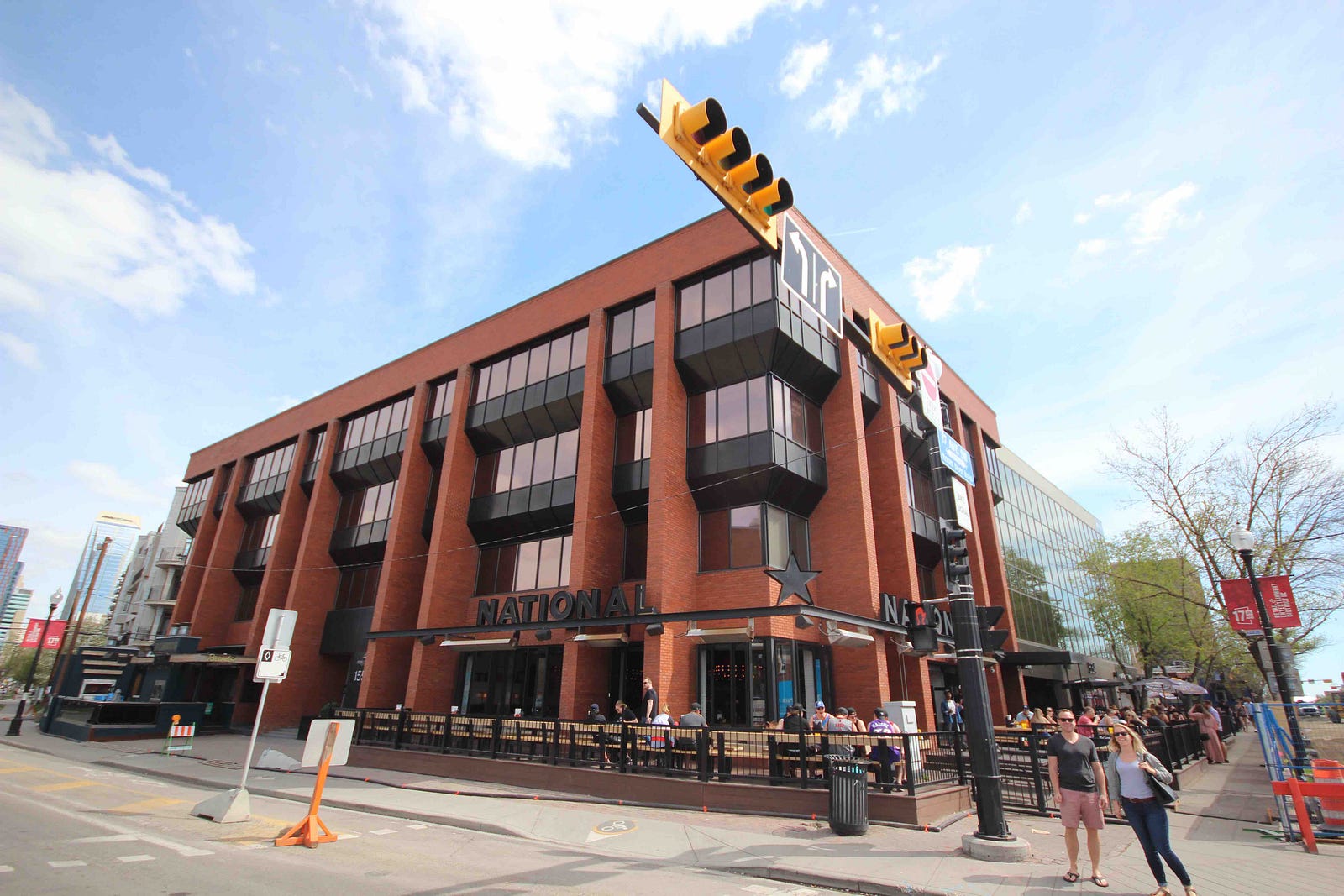
Mission, over a decade ago, went through a similar thing. And the development that came out of it wasn’t all good, but there was some awesome stuff. If you know the building where the Phil & Sebastian is today, it’s called the Maxwell Bates building, that is a beautiful building that I think brings architecture to the street and sort of the scale to the street. That pays homage to the neighbourhood and its past, but also it’s contemporary and it’s new.
It brings office space above in the case of that building, but some of the buildings I think that are being proposed by Arlington bring shops on the bottom, residential on top and maybe even some office space.
I don’t think we’re at a point where there’s too many people living in the Beltline or on 17 Ave. In fact, I think most people would agree that more people living in the area will only help sustain more businesses and grow this area.
And so if we develop more residences along 17 Ave, we’ll have busier streets. I think if we are able to, in a way that’s thoughtful with the street, with right-sized sizing of new commercial retail spaces, we can bring a lot more to the street that isn’t possible within the current types of shops.
Keep in mind too that 17 Ave also has a lot of really bad shitholes. I mean, there’s still a number of fast food drive-thru restaurants on 17 Ave. They aren’t contributing to the street. So while we might lose some of these cool little houses that will be missed, I think there’s also an opportunity to do more.
JEREMY: Awesome. Well thanks very much for your time Peter.
PETER: Hey thanks for having me Jeremy.
[C-TRAIN BING BONG]
‘Calgary has tower envy’
JEREMY: To find out more about the challenges and opportunities of this street, I sat down with Rollin Stanley. He’s the city’s general manager of urban strategy. And he’s a whirlwind. It’s like he drinks 10 cups of coffee every morning…. actually, he doesn’t drink coffee.
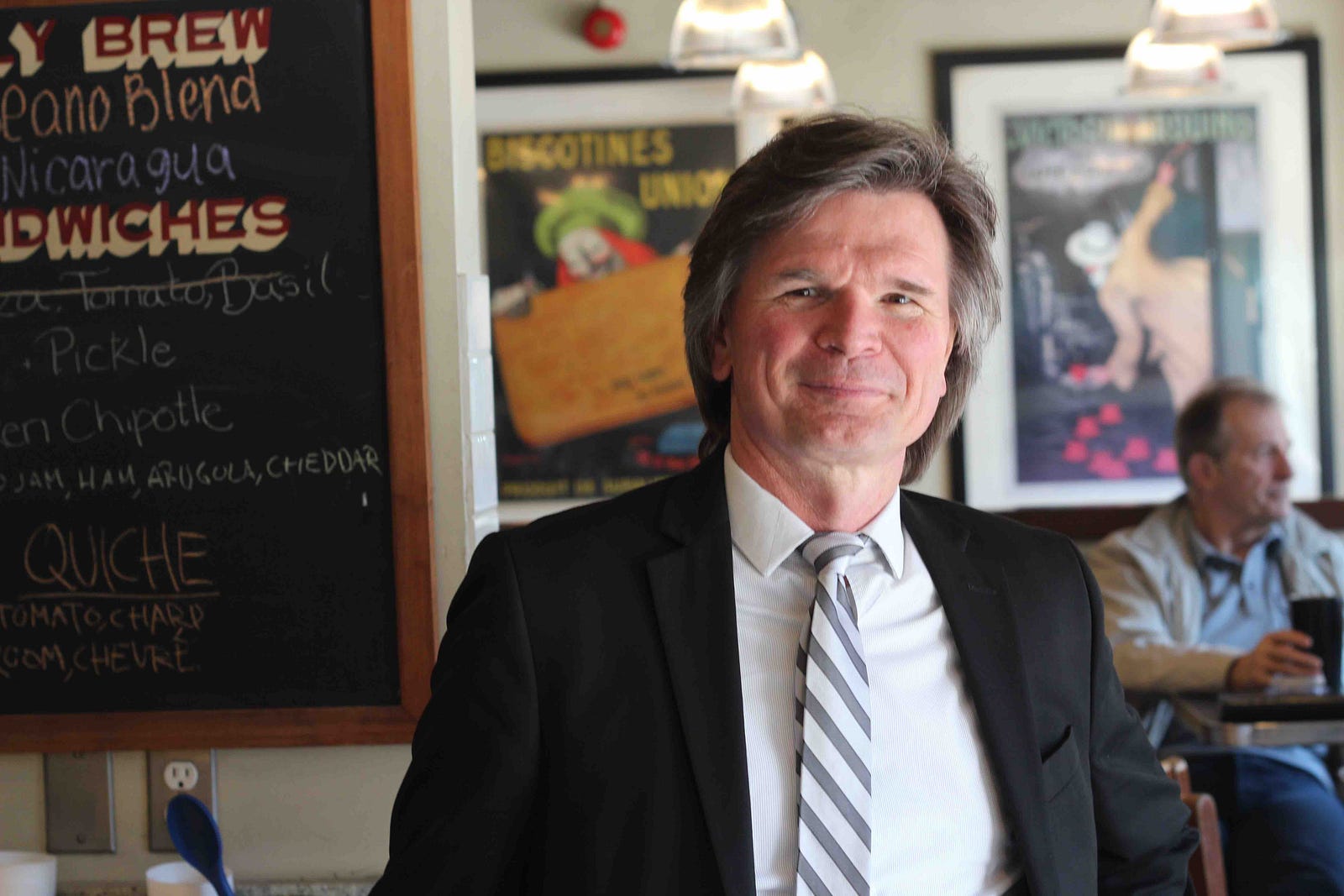
[NOISE IN CAFE]
ROLLIN STANLEY: I’ll see if they have a — oh, they do. They have London Fog.
JEREMY: Yeah, the London Fogs are popular here.
STANLEY: Everybody makes it differently.
JEREMY: Before he was recruited to the City of Calgary, Rollin worked in Toronto, in St. Louis and Washington, DC. He often talks about what he learned in those places. And he’s an agitator. He wants discourse around planning issues in Calgary to be more robust.
ROLLIN: Calgary has tower envy. They look at Toronto, they look at Vancouver, they have tower envy. Which is unfortunate, because I’d like to have a real big debate about maybe that’s not what Calgary is. Calgary is mid-rise buildings up to about 12 or 15 floors. And one of the challenges here is trying to maintain the character that everybody loves about 17th, which means — and we have a good example of it here, where the taller building is set back to the south of the lane.
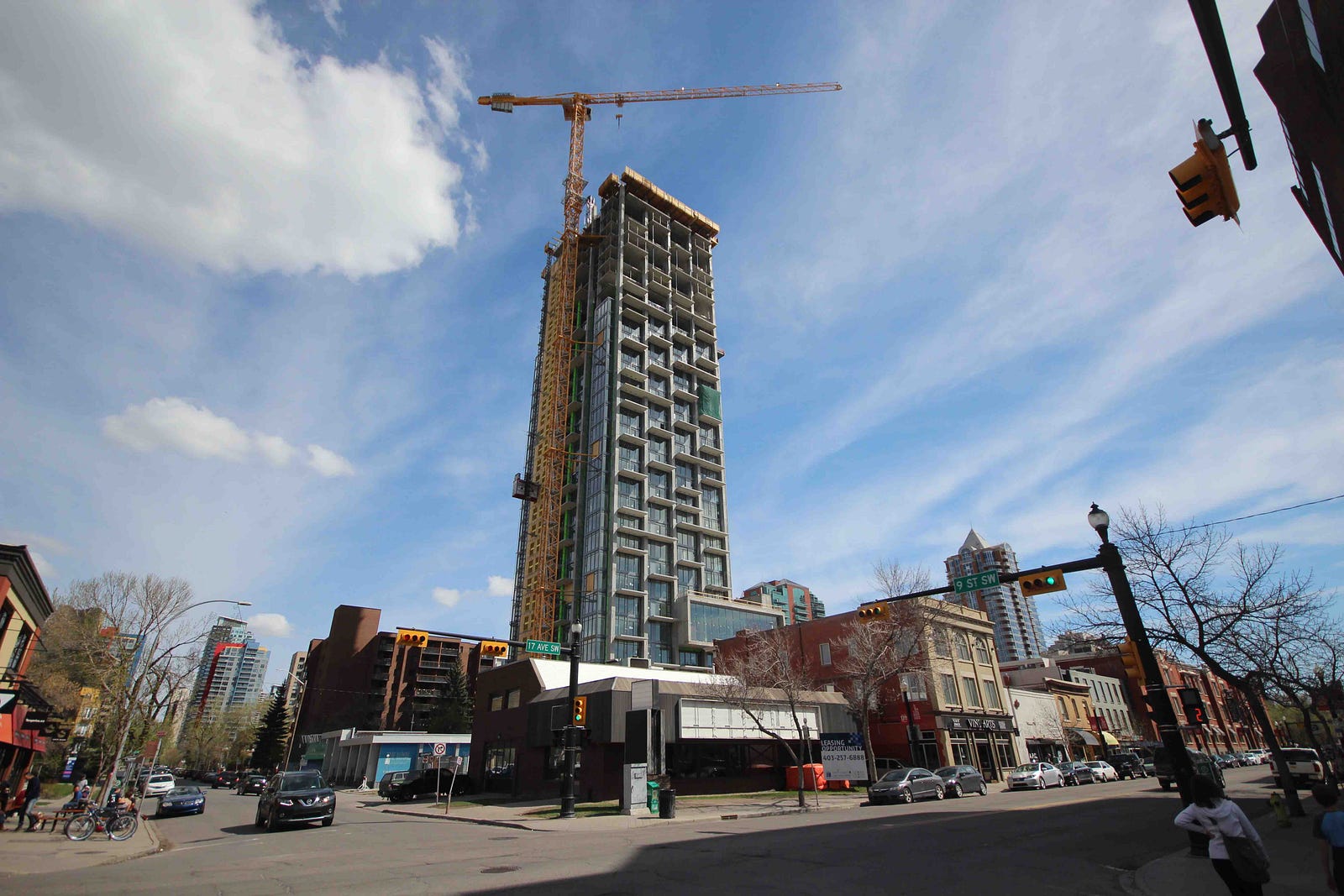
JEREMY: Instead of putting tall buildings right on 17th Ave, they could go on 16th Ave for example, north of Tomkins Park.
ROLLIN: We have a unique opportunity here to allow the taller buildings in that area, while preserving the lower scale on the street itself. Where, if you’re walking down the street, you don’t even see the tower. That’s a unique opportunity for us.
‘Think about it like you think about shopping malls’
ROLLIN: There’s a company, you’ve probably read in the press recently, Arlington, that’s bought 8 or 10 or 12 properties, where that’s the discussion that’s happening with them now. There’s another company, Atlas, that has a number of properties. Those are the discussions we’re having. And when you think of Calgary and you talk to developers, nobody ever wants to be the first in the area but they don’t want to be the last either.
And so you’re looking at companies acquiring property to try and create a brand or a vision for the street if you will, where there’s more continuity. It’s more likely to draw people to the area.
One of the good things that an Arlington plan does is it will open up more space for retail.
JEREMY: Rollin said this is especially important on the east end of the street, close to Macloed Trail where there’s not a lot of retail right now.
ROLLIN: We’ve got to do something to that end of the street to get more wealth going — and by wealth, I mean things happening — to that end. And even on 17th west of where we are.
You’ve got to think about it like you think about shopping malls. You’ve got Macy’s at one end and you’ve got Lord & Taylor at the other — the two big anchors. And then you have the activity between. We’ve got to move in that direction. Now, CMLC came out with their Vic Park master plan. Okay, but that’s not going to do it.
‘There will be displacement’
JEREMY: So developers have all these grand plans. But what’s the city’s role in all of this?
ROLLIN: The role that the city can play is with respect to regulations like heights. And that’s why I was just talking about this street and keeping the buildings lower right on the street and then behind them you can go a bit higher.
Keep in mind that Calgary has lots and lots of places to develop. And so there will be displacement all over the city as places become popular, and we’ve already seen that here. At the end of the day, what are the rents? And are the rents affordable for people to go in and do something?
I have, in other places, created zoning regulations that have limited the size of retail base. Keeping them smaller is a way of keeping them more affordable. That doesn’t mean you’re not paying a high per-square-foot charge. It means the spaces are smaller so they become more affordable in their entirety. So there are other ways to do it. In Canada the tools are a lot more limited than they are south of the border.
‘Do we need bike lanes on 17th? No’
JEREMY: I also asked him why the city isn’t making 17th more bike friendly.
ROLLIN: I rode my bike to work in Toronto. Part of it was on a bike lane, most of it wasn’t. I loved it. I loved the interaction with vehicles. I loved the vibrancy of that. You go to our city — even on my street, on 2nd Street SW, there’s no bike lanes but my word there’s a lot of bikes on that street. And that’s a good thing.
So there are places for bike lanes, there are places where they become more challenging.
One of the great things about this kind of a corridor is all of the things that happen on it. And you actually want the cars parking there. People like to be able to park near where they’re going. And plus, it provides — we did this in St. Louis. We redid the main commercial street, and there was a debate about whether you put in bike lanes or parking. We won the debate to put in the parking — and been very successful, because when people have cars on one side, they feel protected from what’s happening in the street. They feel more secure in the evenings.
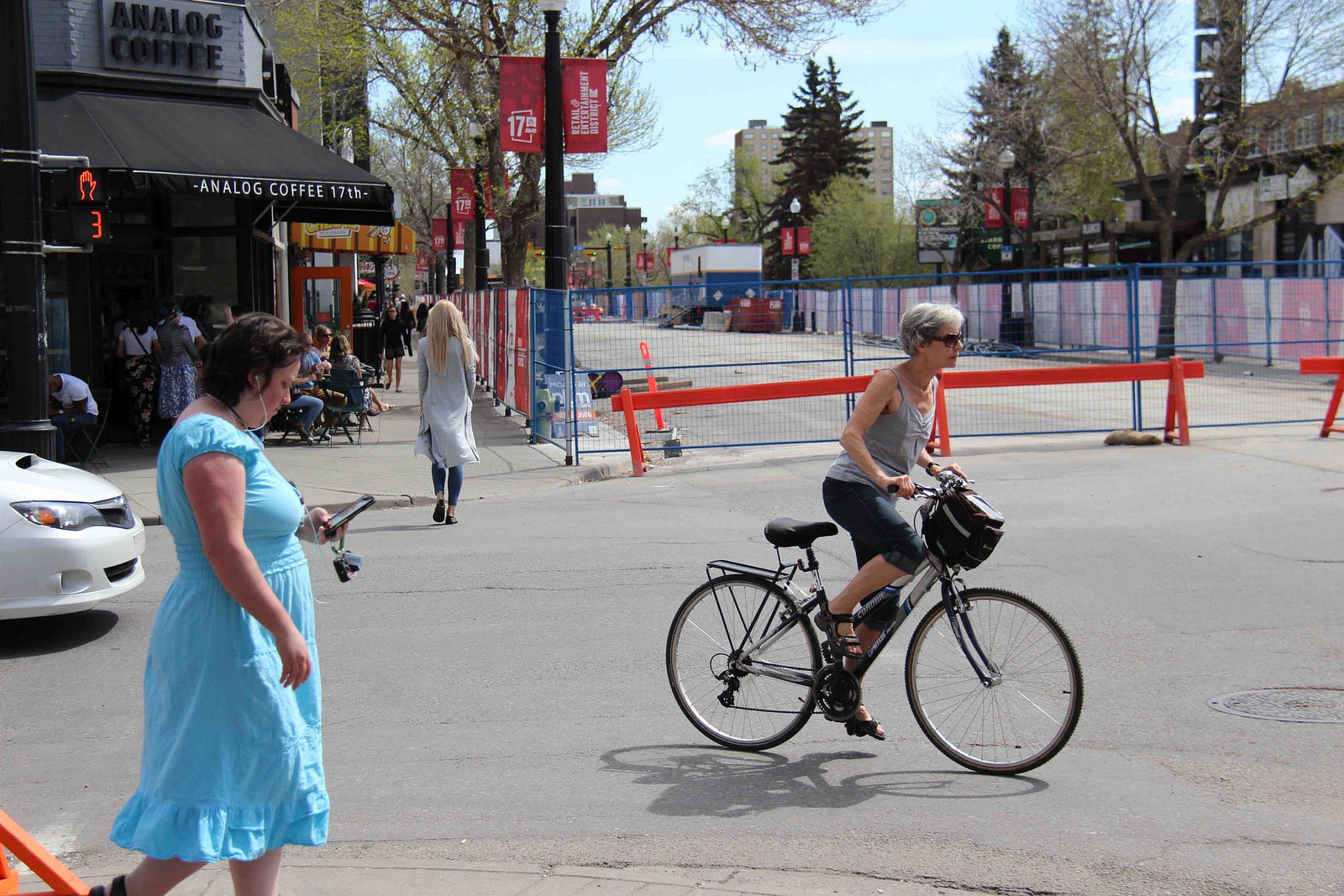
Do we need bike lanes on 17th? No, I’d put them on 16th or 19th. I ride my bike through here all the time. I don’t live that far from here. I’ll ride over to MEC. I love it.
‘We need those little businesses’
JEREMY: Everybody has their own take on what makes 17th a great street and what’ll make it even better in future. So as a city let’s keep this conversation going so we all have a say in what this street becomes. And in the meantime, there’s something that all of us can do right now, or later this week, to make this a better street.
I’m going to give the last word to Margie.
MARGIE GIBB: What I would say to people is make sure you visit all those places, even if there are fences up or whatever. It’s essential that to keep the interesting piece about 17 Ave, we need those little businesses. And it’s real tough. It’s been a rough year, it’s been a rough couple of years.
So they need people to visit them. And they need support.
Jeremy Klaszus is editor-in-chief of The Sprawl.
If you like what you’ve heard/read here, please become a monthly supporter of the Sprawl so we can keep doing in-depth journalism like this!
Support in-depth Calgary journalism.
Sign Me Up!We connect Calgarians with their city through in-depth, curiosity-driven journalism—but can't do this alone! We rely on our readers and listeners to fund our work. Join us by becoming a Sprawl member today!
